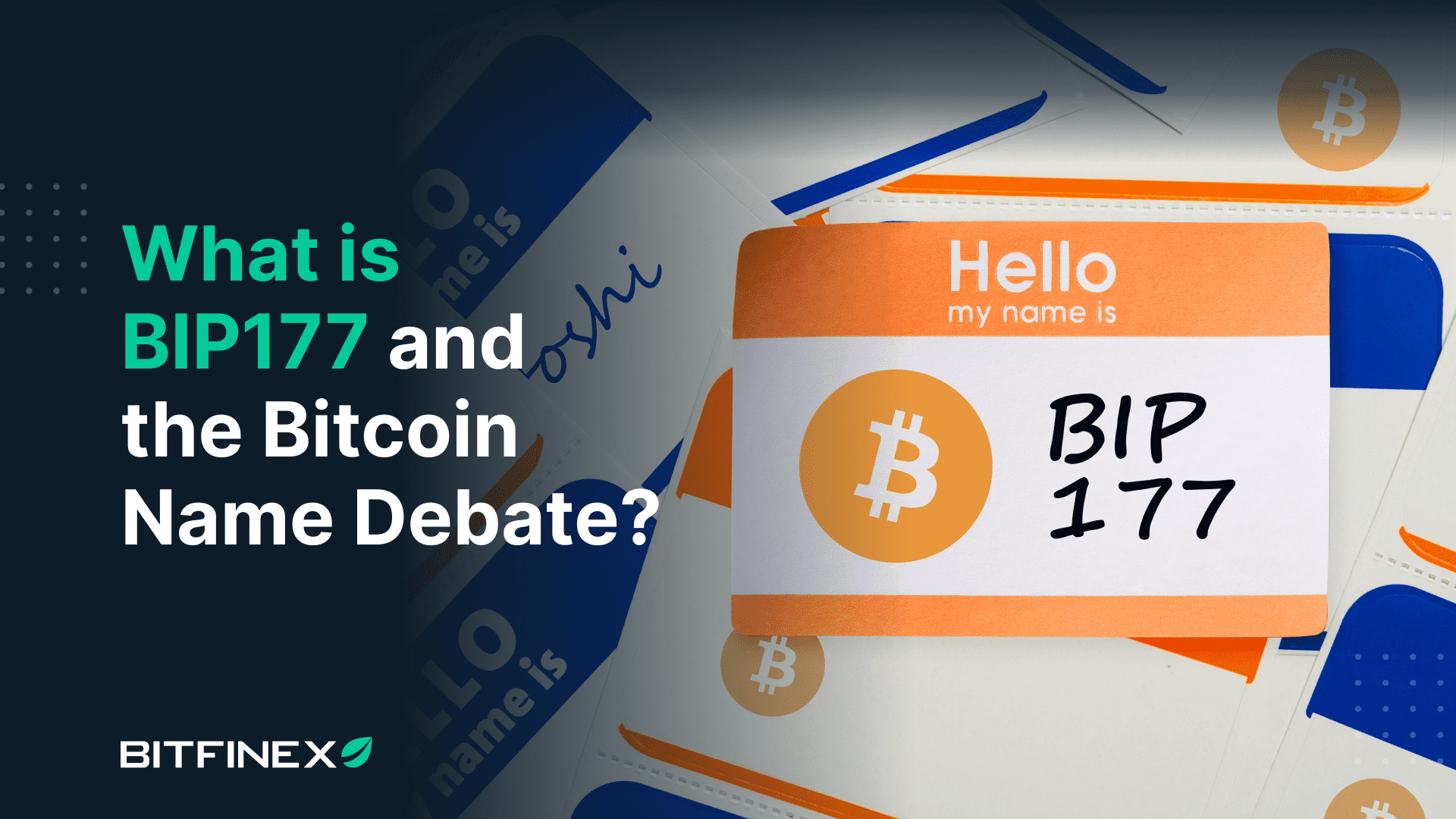
06 Jun What is BIP177 and the Bitcoin Name Debate?
The Bitcoin name debate is a longstanding, sometimes heated debate, about what to name the Bitcoin unit after the decimal point. It also highlights a deeper tension between the cultural tradition and the usability of Bitcoin. The main proposal is that the decimal should be removed and Bitcoin’s smallest unit be renamed to “Bitcoins”, and become the default denomination for everyday use. While the satoshi has become a symbolic and widely recognised unit, some developers and thought leaders argue that the “bit”, equal to 100 sats, is more intuitive for mainstream adoption, especially as Bitcoin’s value grows. This conversation has gained urgency with the emergence of BIP 177, a proposal by Synonym CEO John Carvalho that reimagines Bitcoin’s user interface by removing decimals entirely and standardising bitcoins as the base unit for display. As with previous changes like SegWit or Taproot, meaningful shifts in user experience often require years of discussion, as well as testing and coordination. Whether BIP 177 succeeds or stalls will depend not just on merit, but on the community’s willingness to evolve Bitcoin’s interface for a global audience.
After 16 Years, Why Debate the Name of BTC’s Smallest Unit Now?
Bitcoin, as a digital asset, is divisible into extremely small units to facilitate a wide range of economic activity, from high-value transfers to microtransactions. The most well-known unit is the satoshi, representing 1/100,000,000 of a bitcoin. The term “satoshi,” or “sat,” was first proposed on Bitcointalk.org in 2010 and gained traction after a user named Ribuck proposed using it to refer to the smallest possible division (he also proposed the name “austrian” in homage to the Austrian School of Economics), aligning with a comment by Hal Finney in support of standardised subdivisions. Over time, the community embraced the satoshi as the atomic unit of Bitcoin, partly in honour of Bitcoin’s pseudonymous creator, Satoshi Nakamoto. It became a cultural shorthand, for example “stacking sats”, and remains widely used in wallets and discussions across the Bitcoin ecosystem.
However, another denomination, the bit, equal to 100 satoshis or 1/1,000,000 of a bitcoin, has also been proposed as a more intuitive way to express smaller values. The term “bit” appeared in early Bitcoin discourse and gained renewed attention due to its simplicity and resemblance to conventional currency formats. Prominent voices such as Adam Back have suggested reviving bits for mainstream adoption, noting that if bitcoin’s price reaches $1 million, then 1 bit would conveniently equal $1, making mental conversions easier. Supporters argue that bits map more closely to everyday language and economic behaviour, whereas sats, with their large numerical expressions, are cognitively burdensome for the average user. Thus, the sats vs. bits debate highlights a tension between cultural tradition and user-friendly design.
Bitcoin has several different unit denominations, BTC, mBTC (millibitcoin), µBTC (microbitcoin or “bits”), and satoshis, which can be confusing for non-programmers and everyday users. One full bitcoin (1 BTC) equals 1,000 mBTC, 1,000,000 bits (µBTC), or 100,000,000 satoshis. This variety creates unnecessary complexity, especially when users encounter tiny decimal places like 0.000043 BTC or 4300 satoshis, making it hard to grasp how much something actually costs. Under BIP 177, a whole Bitcoin, 100 million Satoshis, could be referred to as a “Mega Bitcoin”. For those not accustomed to dealing with micro-denominations or scientific notation, the inconsistent unit usage across wallets and platforms can feel alienating, impenetrable, and needlessly technical, resembling software developer logic more than consumer-friendly money.
In 2025, BIP 177 was introduced by Synonym CEO John Carvalho as a proposal to redefine Bitcoin’s commonly understood unit by making the base unit, the smallest indivisible amount recorded on-chain, the new standard for display. Instead of representing bitcoin amounts using simulated decimals (e.g., 0.00004321 BTC), this proposal recommends eliminating the decimal point entirely and referring to each base unit as one “bitcoin.” Under this model, what was previously called one “satoshi” (1/100,000,000 BTC) would now simply be labelled one bitcoin, aligning user interfaces with the reality that Bitcoin’s protocol natively handles integer values, not floating-point decimals. Proponents argue that the decimal system is a legacy UI abstraction that causes confusion, particularly for newcomers who struggle with parsing small fractional amounts. While BIP 177 makes no changes to consensus rules or on-chain data, it would require a coordinated shift in wallet and exchange interfaces and presents a cultural challenge to entrenched terminology like “sats.” By standardising integer-based displays, the BIP aims to simplify education, reduce cognitive load, and reflect the true nature of Bitcoin’s integral accounting.
The motivation behind this shift is largely pragmatic. As Bitcoin grows in value and adoption, most people will never own a full BTC. Presenting balances in whole integers, whether as “bits,” renamed “bitcoins,” or otherwise, helps demystify the asset for newcomers. Critics of BIP 177 argue that removing the satoshi label might erase a piece of Bitcoin’s cultural history, while others view the change as a necessary evolution for mass usability. Regardless of the outcome, the conversation underscores a broader point: unit representation is not just technical, it shapes perception, accessibility, and ultimately, adoption. The debate between sats, bits, and the BIP 177 vision reflects Bitcoin’s ongoing process of refining its monetary interface for a global audience.
Bitkit Wallet is the First to Embrace the BIP 177 Standard
Synonym’s Bitkit wallet is a self-custodial Bitcoin and Lightning wallet focused on enabling a user-friendly experience for onboarding everyday people into the Bitcoin ecosystem. Developed by Synonym, a Bitfinex sister company committed to creating the tools and infrastructure for a self-sovereign atomic economy-based future, Bitkit emphasises privacy, interoperability, and sovereignty. It integrates a variety of features, including a built-in Lightning node, contact-based payments using decentralised identifiers (DIDs), and seamless backup via encrypted cloud anchors. But beyond its advanced functionality, Bitkit has emerged as a trailblazer in wallet design through its early and enthusiastic adoption of BIP 177.
BIP 177 introduces a clear, consistent specification for displaying Bitcoin values using intuitive unit naming and formatting. Rather than defaulting to BTC (bitcoin) or confusing fractions like mBTC or µBTC, BIP 177 proposes using “bitcoins” as the standard display unit, where 1 BTC equals 100,000,000 bitcoins. This unit size is far more approachable and human-friendly, especially for new users, as it avoids awkward decimals. For example, instead of showing a transaction as “0.000043 BTC,” a wallet adhering to BIP 177 would display “43 bitcoins.” This makes Bitcoin feel less like a foreign technical currency and more like a usable medium of exchange with comprehensible denominations, echoing familiar currency experiences like cents or satoshis.
Bitkit’s decision to lead the adoption of BIP 177 is significant because user experience remains one of the biggest hurdles to Bitcoin mass adoption. Most Bitcoin wallets still default to BTC or satoshi denomination, which can alienate or confuse non-technical users. By championing BIP 177, Bitkit provides a more readable, accessible interface that removes friction at the onboarding stage. In doing so, it sets a new usability standard and pressures other wallet developers to rethink their own UI/UX conventions. Bitkit’s implementation is not just symbolic; it offers a working example of how standardisation across wallets could improve interoperability and reduce learning curves across the Bitcoin ecosystem.
Does BIP 177 Have the Community Support to Become a Lasting Change in Bitcoin?
The adoption of BIP 177 remains uncertain, as there is currently no clear community-wide consensus among wallet developers, exchanges, and end users, although Jack Dorsey’s Square has adopted the standard recently. While some forward-thinking projects like Synonym’s Bitkit have embraced the standard, most Bitcoin applications continue to default to displaying BTC or satoshis. This reflects a deeper reality in Bitcoin development: changing widely adopted standards, especially those involving user interface conventions, is notoriously difficult. Many users and developers are resistant to altering established norms, even when the proposed change improves accessibility. Without a coordinated push from major players in the ecosystem, wallets, payment processors, educational platforms, BIP 177 risks becoming another well-intentioned but sidelined proposal.
The challenge is rooted in how Bitcoin’s consensus culture and BIP process work. BIPs (Bitcoin Improvement Proposals) are suggestions submitted to improve various aspects of the protocol or its ecosystem, ranging from core consensus changes to UI conventions like unit display. While some BIPs require network-wide consensus and node upgrades (like soft forks), others, such as BIP 177, are non-consensus changes that depend on voluntary adoption by developers and service providers. Even so, any meaningful change in Bitcoin must navigate a fragmented, cautious, and fiercely sceptical community. Because Bitcoin’s decentralisation is its greatest strength, no single authority can mandate change, even something as seemingly minor as how users see numbers on their screens. As Bitcoin’s value rises and 1 satoshi inches closer to dollar parity, a more intuitive display standard like BIP 177, using bitcoins instead of decimals, could gain broader support by making everyday transactions easier to understand and mentally convert.
Historically, even changes with clear technical merit, like SegWit (BIP 141) or Taproot (BIP 341), took years to gain traction. SegWit, for example, was proposed in 2015 and didn’t activate until 2017, after intense debate and social coordination including a user-activated soft fork (UASF) and miner signalling battles. These examples highlight how deeply conservative and consensus-driven the Bitcoin ecosystem is. The reluctance to embrace even minor interface tweaks is not necessarily apathy or obstructionism, it’s a reflection of a culture deeply wary of change without widespread agreement and rigorous testing. This conservatism helps ensure Bitcoin’s long-term resilience but can also delay user experience improvements.
In this context, BIP 177 may or may not become the de facto unit display standard. One advantage of BIP 177 is that it is a voluntary or opt-in change, so adoption can take place voluntarily, allowing for wallets and exchanges to implement the standard when they are ready. Wallet developers would need to coordinate display logic, exchanges would have to support bits in pricing and withdrawals, and users would need to learn a new mental model of value representation. Without strong leadership from high-profile apps or companies, or a groundswell of grassroots demand, BIP 177 may join the long list of Bitcoin proposals that linger in limbo, not rejected, but not adopted either. Currently, several Bitcoin-focused projects like Spiral, Square, Workit, and Cashu are in varying stages of BIP 177 adoption. In a protocol where “don’t change it” is the default stance, even a modest improvement like BIP 177 must clear a high bar to earn its place in the standard toolkit of Bitcoin tools.



